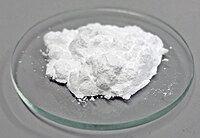Lanthanum(III) oxide
 |
|
 |
|
| Names | |
|---|---|
|
IUPAC name
Lanthanum(III) oxide
|
|
| Other names
Lanthanum sesquioxide
Lanthana |
|
| Identifiers | |
| ChemSpider | |
| ECHA InfoCard | 100.013.819 |
|
PubChem CID
|
|
| RTECS number | OE5330000 |
|
|
| Properties | |
| La2O3 | |
| Molar mass | 325.809 g/mol |
| Appearance | White powder, hygroscopic |
| Density | 6.51 g/cm3, solid |
| Melting point | 2,315 °C (4,199 °F; 2,588 K) |
| Boiling point | 4,200 °C (7,590 °F; 4,470 K) |
| Insoluble | |
| Band gap | 4.3 eV |
| −78.0·10−6 cm3/mol | |
| Structure | |
| Hexagonal, hP5 | |
| P-3m1, No. 164 | |
| Hazards | |
| Main hazards | Irritant |
| R-phrases (outdated) | R36/37 |
| S-phrases (outdated) | S26, S22, S37/39 |
| NFPA 704 | |
| Flash point | Non-flammable |
| Related compounds | |
|
Other anions
|
Lanthanum(III) chloride |
|
Other cations
|
Cerium(III) oxide Scandium(III) oxide Yttrium(III) oxide Actinium(III) oxide |
|
Related compounds
|
Lanthanum aluminium oxide, LaSrCoO4 |
|
Except where otherwise noted, data are given for materials in their standard state (at 25 °C [77 °F], 100 kPa).
|
|
|
|
|
| Infobox references | |
Lanthanum oxide is La2O3, an inorganic compound containing the rare earth element lanthanum and oxygen. It is used to develop ferroelectric materials, as a component of optical materials, and is a feedstock for certain catalysts.
La2O3 has a band gap at approximately 5.8 eV. It has the lowest lattice energy, with very high dielectric constant, ε = 27. La2O3 is widely used in industry as well as in the research laboratory. Lanthanum oxide is an odorless, white solid that is insoluble in water, but soluble in dilute acid. Depending on the pH of the compound, different crystal structures can be obtained. La2O3 is hygroscopic; under atmosphere, lanthanum oxide absorbs moisture over time and converts to lanthanum hydroxide. Lanthanum oxide has p-type semiconducting properties. Its resistivity decreases with an increase in temperature. Its average room temperature resistivity is 10 kΩ·cm.
At low temperatures, La2O3 has an A-M2O3 hexagonal crystal structure. The La3+ metal atoms are surrounded by a 7 coordinate group of O2−atoms, the oxygen ions are in an octahedral shape around the metal atom and there is one oxygen ion above one of the octahedral faces. On the other hand, at high temperatures the Lanthanum oxide converts to a C-M2O3 cubic crystal structure. The La3+ ion is surrounded by a 6 coordinate group of O2− ions.
There are several elements which were discovered as a consequence of the lengthy analysis and breakdown of the ore Gadolinite. As the ore was progressively analysed further, the residue was given the label thence ceria and thence lanthana and onwards to yttria, erbia, and terbia. The list by date includes Cerium 58, Lanthanum 57, Erbium 68, Terbium 65, Yttrium 39, Ytterbium 70, Holmium 67, Thulium 69, Scandium 21, Praseodymium 59, Neodymium 60 and Dysprosium 66. Several of these new elements were either discovered or isolated by Carl Gustaf Mosander in the 1830s and 1840s.
...
Wikipedia

